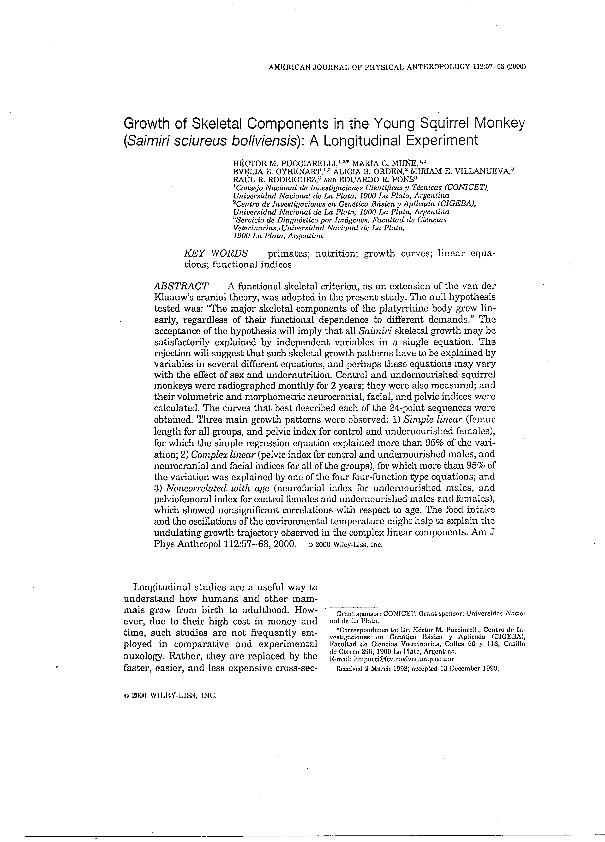Artículo
Growth of skeletal components in the young squirrel monkey (Saimiri sciureus boliviensis): A longitudinal experiment
Pucciarelli, Hector Mario ; Muñe, Maria Cristina
; Muñe, Maria Cristina ; Oyhenart, Evelia Edith
; Oyhenart, Evelia Edith ; Orden, Alicia Bibiana
; Orden, Alicia Bibiana ; Villanueva, Miriam E.; Rodríguez, Raúl R.; Pons, Eduardo R.
; Villanueva, Miriam E.; Rodríguez, Raúl R.; Pons, Eduardo R.
 ; Muñe, Maria Cristina
; Muñe, Maria Cristina ; Oyhenart, Evelia Edith
; Oyhenart, Evelia Edith ; Orden, Alicia Bibiana
; Orden, Alicia Bibiana ; Villanueva, Miriam E.; Rodríguez, Raúl R.; Pons, Eduardo R.
; Villanueva, Miriam E.; Rodríguez, Raúl R.; Pons, Eduardo R.
Fecha de publicación:
05/2000
Editorial:
Wiley-liss, Div John Wiley & Sons Inc
Revista:
American Journal Of Physical Anthropology
ISSN:
0002-9483
Idioma:
Inglés
Tipo de recurso:
Artículo publicado
Clasificación temática:
Resumen
A functional skeletal criterion, as an extension of the van der Klaauw's cranial theory, was adopted in the present study. The null hypothesis tested was: "The major skeletal components of the platyrrhine body grow linearly, regardless of their functional dependence to different demands." The acceptance of the hypothesis will imply that all Saimiri skeletal growth may be satisfactorily explained by independent variables in a single equation. The rejection will suggest that such skeletal growth patterns have to be explained by variables in several different equations, and perhaps these equations may vary with the effect of sex and undernutrition. Control and undernourished squirrel monkeys were radiographed monthly for 2 years; they were also measured; and their volumetric and morphometric neurocranial, facial, and pelvic indices were calculated. The curves that best described each of the 24-point sequences were obtained. Three main growth patterns were observed: 1) Simple linear (femur length for all groups, and pelvic index for control and undernourished females), for which the simple regression equation explained more than 95% of the variation; 2) Complex linear (pelvic index for control and undernourished males, and neurocranial and facial indices for all of the groups), for which more than 95% of the variation was explained by one of the four four-function type equations; and 3) Noncorrelated with age (neurofacial index for undernourished males, and pelviofemoral index for control females and undernourished males and females), which showed nonsignificant correlations with respect to age. The food intake and the oscillations of the environmental temperature might help to explain the undulating growth trajectory observed in the complex linear components.
Palabras clave:
Primates
,
Nutrition
,
Growth Curves
,
Linear Equations
,
Functional Indices
Archivos asociados
Licencia
Identificadores
Colecciones
Articulos(IGEVET)
Articulos de INST.DE GENETICA VET ING FERNANDO NOEL DULOUT
Articulos de INST.DE GENETICA VET ING FERNANDO NOEL DULOUT
Citación
Pucciarelli, Hector Mario; Muñe, Maria Cristina; Oyhenart, Evelia Edith; Orden, Alicia Bibiana; Villanueva, Miriam E.; et al.; Growth of skeletal components in the young squirrel monkey (Saimiri sciureus boliviensis): A longitudinal experiment; Wiley-liss, Div John Wiley & Sons Inc; American Journal Of Physical Anthropology; 112; 1; 5-2000; 57-68
Compartir
Altmétricas



